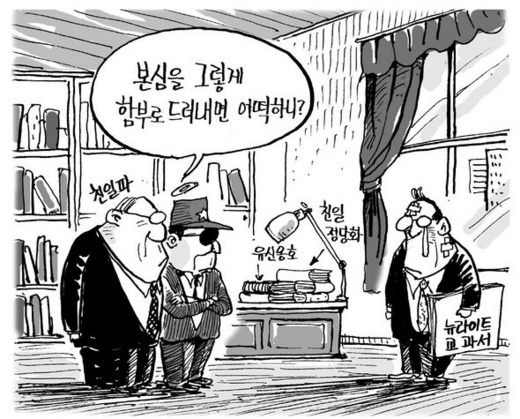First, thanks for allowing me into the Frog in a Well project. You’ve set a high standard. I promise not to call it “Frog Blog” or “Frog in the Throat.”
My training — before I got into teaching and discovered what I was really interested in — was in modern Chinese history. I started back in the 1960s when the People’s Republic was “Red China” and Americans couldn’t go there (legally). I was sucked in by a course distribution requirement. The course was pretty good, so I took another, then another, graduated and went to Taiwan for a year, and then … well, here I am.
My first teaching job was at Oberlin College, where I taught pretty much everything Asian. Then in 1978 I went to Chinese University of Hong Kong to be the Representative of the Yale-China Association and Associate Director of the International Asian Studies Programme. The late ’70s and early 1980s was a great time to be there. The PRC was opening up to Americans and we quickly confirmed that Mao was not who we had read about in Red Star Over China and saw a China which was not in Peking Review.
Then it was my wife’s turn to get the first job, which turned out to be in Chicago. Since then I’ve been an Independent Scholar (a euphemism for unemployed), a Visiting Professor at numbers of places, and a Visiting Scholar at Northwestern.
My first book was To the People: James Yen and Village China (Columbia University Press, 1990), which told the story of Yan Yangchu (1890-1990) and the Rural Reconstruction Movement. Yen founded the Mass Education Movement which first conducted nationwide literacy campaigns, then set up the Ting Hsien [Ding Xian, in Hebei] Experiment from 1926 until 1937. Before the Japanese invasion forced them out, Yen’s group developed a four fold community development model which started from education and then moved to health, economics (agricultural improvement, coops, etc. etc.), and local government reform. The book argued that perhaps Yen’s non-violent approach — call it “liberal” — fit the needs of the villages better than did leftist attack on “feudalism,” but Yen did not match Mao’s grasp of politics.
In China today there is New Rural Reconstruction Movement which is explicitly based in the thought of James Yen and has headquarters in Ding Xian, Hebei. A few years ago there was also an interest in the role of Public Intellectuals which was quietly suppressed, and a widespread growth of NGO’s. I’d like to write and compare these movements with the situation in the 1920s and 1930s.
My book project now is America’s Chinas: From The Opium Wars to Tiananmen. This compares the various Chinas construed in books written in China by Americans for the folks back home. This looks at how relatively well-informed men and women presented China, both the ideas behind their arguments but also their rhetoric — words, metaphors, tropes, and stories. S.W. Williams The Middle Kingdom (1st ed. 1848) leads off, then Arthur Smith’s Chinese Characteristics (1894), then to, among others, Pearl Buck’s The Good Earth (1931), Alice Tisdale Hobart’s Oil for the Lamps of China (1934), and the wartime reporters’ books such as Snow’s Red Star Over China (1937), White and Jacoby’s Thunder Out of China (1946), and Jack Belden’s China Shakes the World (1949). An excerpt is at Asia Media in “Snow, White, and the Seven China Reporters’ Books,” based on a paper at the 2006 Association for Asian Studies.
The books in America’s Chinas were written in plain language, with no footnotes, and for a general audience, that is, by “amateurs,” people who may have spent decades in China, but lacked PhD’s. Pearl Buck, for instance, may well be the single most influential person in the history of relations between the United States and China, but she does not appear in John Fairbank’s book by that name. Not that I want to go down in history as the guy who studied Buck, but I did write a piece “What’s So Bad About the Good Earth?”
To figure out this anomaly, I’ve also looked at the professionalization of China study in the years before 1949. Professionalization meant enclosure within universities, regularization of study, and raising standards, but also American domination, withdrawal from political controversy, cutting off from business and religious elites, an initial decrease in the number of women, and difficulty in reaching the public. One result is the supposed conflict between “academic” and “popular” history, a further interest which I would like to explore on our blog.
I also edit D’Asia Vue, a series for Doug Merwin’s new EastBridge Press. We reprint classics of Western writing on Asia and commission scholarly Introductions. I also am the incoming editor of the Journal of American-East Asian Relations.
Over the last few years I have also developed a course about film in post-Mao China and postwar Japan — or rather, it has developed me. The experience of teaching this course combined with my long term interest in food history to suggest a useful hypothesis: mainstream Hollywood films tend to ignore food or to code it as ethnic – “leave the guns, take the cannoli” – while “Confucian” films see food and eating as reflecting moral character, social landscape, and even politics — Ang Lee’s “Eat, Drink, Man, Women” is only one, rather self conscious example. Stay tuned for further thoughts.
Oh, and I’m also working on the history of Chop Suey.




